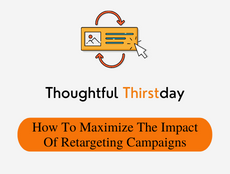You may be surprised to know that 4 out of 5 visitors do not convert to customers during their first visit on any website. They just check out the products and leave the website.
However, this data is fairly shocking for online businesses. Still, if you find the strategy to attract your visitors back to your website, you can not only retain your lost visitors but also maximize the profitability of your business.
But how can this be possible?
The answer is; Using Retargeting strategies. Applying a perfect Retargeting strategy for your business can bring back your website visitors and convert them into your customers.
This is because retargeting includes showing advertisements to users who have already visited your website and are thus far more likely to convert.
Retargeting essentials include creating email lists and installing cookies on various pages throughout your website to target visitors. But now the time has changed, competition is getting rigorous, and you need to employ more sophisticated retargeting campaigns to achieve the best results from your campaign.

Here are the best strategies to help you maximize the impact of retargeting campaigns.
Best Practices to Maximize the Impact of Retargeting Campaigns
1. Visitors’ Segmentation Based on Their Intent
The best thing about retargeting is that you can connect with such a highly relevant audience. However, you can further tailor or segment your target audience based on their intent. You can leverage this segmentation using various tactics, including email and targeted paid advertising.
Try segmenting your website visitors according to their intentions, which you may determine from what brought them to your site. For instance, a person who arrived at a page via a Google search for “digital marketing strategies” may not have the same goals as someone who came via a search for “digital marketing services.” Consequently, you want to use a different ad to target each of them.
2. Target Users Who Click on Your PPC Ads
During retargeting campaigns, one thing you should always keep in mind is that retargeting doesn’t mean retargeting only website visitors. Those who click on your PPC ads on Google can also be your target audience; you should target them, also.
One reason behind this is that the user who has clicked on your PPC Ad, even if he has not visited your website, but he is interested in your business.
A follow-up ad must be made to optimize the campaign’s impact whenever you create a PPC ad. This follow-up advertisement is for those viewers who clicked on your previous PPC advertisement but could not respond due to time constraints or other factors. The follow-up ad will then be displayed to those viewers so they can respond and engage with it.
3. Always Create Different Ads for Different Website Pages
If you provide a variety of products or services, then it is obvious that the content on every page of your website is different from one another. So whenever you create an ad, don’t use the same ad for every page. Use different ads for other website pages (as they have additional content). Be careful while targeting particular pages with your retargeting advertisements when you set them up on your website.
The advertisement for the “About Us” page will be displayed for the eager individual to grab information about your business. And Ads for particular products and services will be shown to those looking for products or services.
In connection with that, you might consider increasing your ad bids for your website’s most valuable pages. Ads for those who have visited specific product pages are worth more than those for people who have merely looked at your homepage.
4. Target Users Who are Most Active on Your Website
The user spending more time on your website keeps interested in your products or services.
A user who spends 1 hour on your website, looking at several pages, is substantially more likely to make a purchase from you than a person who only looks at one page before leaving. So, overall giving attention to those visitors who stay on your website for a longer time will be highly beneficial for you.
They are your most valued potential customers, regardless of how frequently or long they visit or stay on your website. By looking at stats in Google Analytics, which can monitor the traffic to your site, you may determine who lasts on it the longest.
5. Focus on Advertisement Frequency
Many advertisers don’t always think about frequency when planning their retargeting ad campaigns. But it is one of the most important parts of the retargeting campaign that increases the whole campaign’s effectiveness.
Think of yourself; whenever you encounter a repetitive ad, your viewpoint might shift from positive to negative. It might make you angry or deteriorate the brand’s image. And at last, it may impact both present and future sales.
So, your ad should not be repetitive; it should be sent at the right time with the right message.
6. Adopt an emotive approach to your marketing
When going to make a purchase, every buyer thinks he is a sensible, knowledgeable, and experienced customer, but that is only partially true. When making a purchase, the buyer’s emotional side has a lot to say.
Any customer can be convinced by showing the product’s features, telling the product’s practicality, but somewhere the customer also has an emotional self. And when the customer thinks from his emotional self, he sees the product’s features and the benefits.
To effectively reach prospective customers, speaking to their rational and emotional sides is crucial. Be human in your retargeting campaigns.
Say Hello To Us
Need a little assistance to maximize the impact of retargeting campaigns? Sunarc technologies has your back! Our experienced professionals have all the necessary skills to enhance your business’ retargeting efforts besides high-tech digital marketing offerings.
Contact us today and make your next retargeting campaign valuable.

